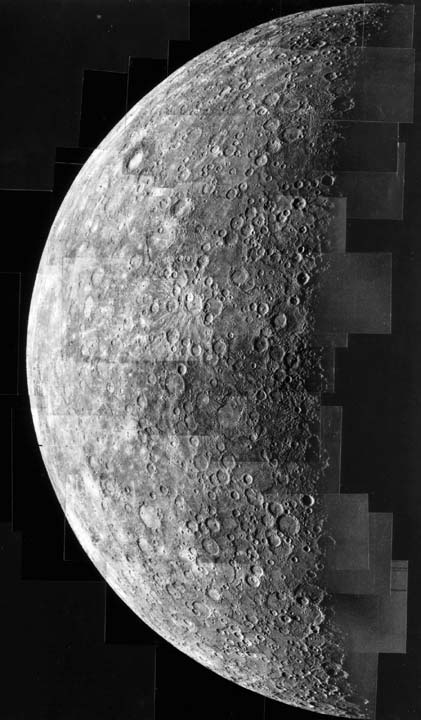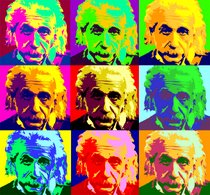“So we must be getting close to Earth now Albert.”
Down to the last few hundred million miles.
“Oh, still that much?”
Don't worry, it will only take us thirty more minutes. After seeing these last few planets we'll go right past the sun. From there it is only another eight minutes to planet Earth.
“So what's next.” The small inner planets. There are four of them Mars, Venus, Mercury and of course Earth. They are very different to the giant gas planets like Jupiter and made of the stuff we usually think planets are made of, rock.
The small inner planets. There are four of them Mars, Venus, Mercury and of course Earth. They are very different to the giant gas planets like Jupiter and made of the stuff we usually think planets are made of, rock.
“We could call them Rocky IV.”
Why?
“It's another film Albert, and like you said there are four inner planets and they're all rocky”
True, is Rocky IV another space film?
“No it's about a boxer, but perhaps we should get back to talking about Mars.” Good idea. Well, see for yourself.
Good idea. Well, see for yourself.
“Those white bits at the north and south poles of Mars, are they ice?”
Of sorts. There is probably water ice under the surface but ice caps on Mars are dry ice, frozen carbon dioxide, CO2.
“Carbon dioxide. Isn't that the stuff causing global warming on earth?”
Well, rising CO2 is a one of the things that might be making the earth warmer because it is a greenhouse gas.
"What's a greenhouse gas?"
A greenhouse gas is any gas that makes planets hotter by trapping the heat from the sun. Normally a lot of the heat that reaches a planet’s surface is lost back into space as infra-red radiation, effectively heat waves. Greenhouse gases absorb the infra-red radiation so the heat stays in the atmosphere rather than escaping into space. This means that more and more of the sun's heat is trapped so the planet warms up.
“So is Mars hot with all that CO2?”
No, Mars is very cold, the hottest places are just about at freezing point, zero degrees Celsius, and the coldest more than minus 100oC. There is a lot of trapped CO2 but it won't work as a greenhouse gas when it is frozen it would have to be in the atmosphere.
“So to make Mars a nicer place to live all you'd have to do is melt all that trapped frozen CO2.”
That could work. As the the martian ice caps melted, carbon dioxide levels would increase. When there was enough carbon dioxide in the atmosphere the greenhouse effect would take over making Mars warmer and warmer. The frozen water that scientists think is under the surface would melt too. Wait a few hundred years for things to settle down and there you have it - a nice new world with an atmosphere, reasonable climate, ripe for exploitation. Mind you there'd be no oxygen to breath so they would have to find some way making that. Perhaps they could use solar energy to break down some of the water into hydrogen and oxygen.
“You are not really being serious are you Albert?”
Well, it's not beyond the power of imagination, but then to my way of thinking very little is. I've discovered that there is even a new word for this - ‘Terraforming’, sounds so much nicer than polluting doesn't it?
“So is there is life on Mars now?”
An interesting question and the short answer is we don't know. Back in the 1920’s when I was still in my prime an American astronomer, Percival Lowell, had the world convinced of an advanced civilisation on Mars with a large system of canals to bring water from the ice caps. When he looked through the best telescopes of the day, he could see these canals criss-crossing Mars. Most other people only saw red blobs, but some people started believing Lovell and started seeing canals too.
“People were really convinced there were little green men on Mars?”
Oh yes. So much so that on August 23rd 1924 when Mars and the Earth were closer than they had been for over 100 years, groups of people set up powerful radio receivers to try and hear any messages from Mars and send messages back to Mars.
“Any one call?”
Not a peep, I’m afraid. As telescopes got better it became clear these canals were only in Percival Lovell’s imagination. By the time space probes were sent to Mars they didn't find canals but what looked like empty river beds. So Mars may have been a friendlier place for life a few billion years ago. Back in 1976 the two Viking space probes landed on the surface with equipment to look for life. Even though they weren't expecting Martians but there might still be Martian bacteria in the soil.
“Did they find anything?”
The results didn't definitely prove there wasn't life, but some of the experiments had unusual results which could just be caused by an unusual form of bacteria.
“Why isn't that bigger news?”
Well they decided overall that they didn't find life, but some scientists are still not so sure. The man who designed one of the experiments, Gilbert Levin, still claims the results could have been caused by simple bacteria. Later on NASA claimed to have found what looked like fossilised bacteria in a meteorite that came from Mars. If life did start on Mars, it would probably survive under gound so they will have to go back and start drilling some holes.
“If there are dry river beds, where did all the water and air go?”
The water probably sank underground and got trapped as ice. Most of the air drifted off into space because there is less gravity on Mars than on the Earth.
“You need gravity to hold the air onto a planet?”
Gravity is the only thing holding the atmosphere and all the air and clouds onto a planet. Mar's problem is really that it was just a little too far from the sun and a little too small. It has only a very thin atmosphere now, but smaller places like the moon have so little gravity that they have no atmosphere at all. Now the next planet on our tour has plenty of atmosphere, Venus.
“That would make it a more likely place for life then?”
Like all things in life, too much of a good thing is bad for you. The main problem with Venus is that its atmosphere is too full of greenhouse gases. It is also closer to the Sun than the Earth or Mars. Although the planet is named after the Goddess of Love, there is nothing lovely about Venus apart from brightly it shines.
“It is beautiful shining planet, you have to admit.”
True, from Earth it is brighter than any star apart from the Sun of course. Venus is called the morning or evening star as it is only seen just before dawn and just after sunset. It’s so bright it is hard to imagine that Venus has no light of its own but just reflects sunlight. Before you get too attached to this shining pearl in your skies, just remember that all that light is reflecting from clouds of sulphuric acid and the temperature on the surface is 450oC, hot enough to melt some metals.
“Has anyone sent probes to the surface of Venus?” The Russians had the most success with Venus, though lots of probes were lost. They sent a whole series of Venera probes but the longest any of the survived was about two hours before the heat and pressure destroyed them. Here's a picture of the surface. Apart from the atmosphere it's really all rocks, just like Mars and the next planet on our journey Mercury.
The Russians had the most success with Venus, though lots of probes were lost. They sent a whole series of Venera probes but the longest any of the survived was about two hours before the heat and pressure destroyed them. Here's a picture of the surface. Apart from the atmosphere it's really all rocks, just like Mars and the next planet on our journey Mercury. “Is that Mercury? Is it just me or does it look a lot like the Earth's moon?”
“Is that Mercury? Is it just me or does it look a lot like the Earth's moon?”
That's Mercury and you are right it doesn't look very different to the moon. No atmosphere and lots of craters. The only problem is the temperature. It is so near the Sun that the days are very hot, around 400oC even without any greenhouse gases. The days are also very long so the sun doesn't set for 88 days at a stretch. As the scenery is much the same as the moon, all things being considered you might as well go to the moon for your holidays as travel all the way to Mercury. Having said that I am rather fond of this little planet.
“Why?”
For a long time there was a small wobble in its orbit that couldn't be explained by Newton's theory of gravity.
“And your theory of relativity explained it?”
Exactly. That little quirk of astronomy was the first evidence that my theories might really be true.
“How about the last planet, Earth? Aren't you going to tell me about that?”
There's plenty of time for that, first I want to demonstrate something very close to my heart.
“What?”
You'll find out in a few minutes. Hold onto your hat.
This is the story of a great journey that started with a great thought. One day in 1895 a boy looked into a mirror and wondered what the universe would look like if he could travel on a beam of light. That sixteen year old boy was Albert Einstein and that one thought started him on the road to discover his Theory of Relativity. The great man has been reinvented as Albert 2.0 to come back and blog about a journey through space on a beam of light and explain the science behind everything from atoms, blackholes to global warming. If you've just joined and want to start at the beginning use the index on the left. If you're bored try these links below just for fun.
UNSCRAMBLE EINSTEIN'S BRAIN
PRACTISE SAVING THE WORLD FROM ASTEROIDS
ALIEN CONTACT CALCULATOR
HEAR THE REAL EINSTEIN TALK ABOUT E=Mc2.
Saturday, September 1, 2007
Rocky IV: The inner planets which are made of errr...rock
2 Comments:
-
- Anonymous said...
September 3, 2007 at 6:47 PMGet back to quantum mechanics and atoms and stuff. Most already know about the planets, names, etc.- Anonymous said...
September 3, 2007 at 9:46 PMTake it easy, if my guess is right thats exactly what he is about to do. After all if I were a beam of light, I think I would be very interested in the effect of passing near something as massive as the sun :D
Subscribe to:
Post Comments (Atom)







